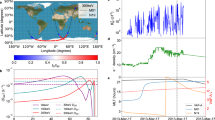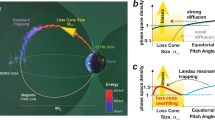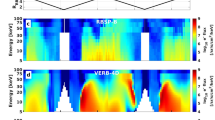Abstract
Over 40 years ago it was suggested that electron loss in the region of the radiation belts that overlaps with the region of high plasma density called the plasmasphere, within four to five Earth radii1,2, arises largely from interaction with an electromagnetic plasma wave called plasmaspheric hiss3,4,5. This interaction strongly influences the evolution of the radiation belts during a geomagnetic storm, and over the course of many hours to days helps to return the radiation-belt structure to its ‘quiet’ pre-storm configuration. Observations have shown that the long-term electron-loss rate is consistent with this theory but the temporal and spatial dynamics of the loss process remain to be directly verified. Here we report simultaneous measurements of structured radiation-belt electron losses and the hiss phenomenon that causes the losses. Losses were observed in the form of bremsstrahlung X-rays generated by hiss-scattered electrons colliding with the Earth's atmosphere after removal from the radiation belts. Our results show that changes of up to an order of magnitude in the dynamics of electron loss arising from hiss occur on timescales as short as one to twenty minutes, in association with modulations in plasma density and magnetic field. Furthermore, these loss dynamics are coherent with hiss dynamics on spatial scales comparable to the size of the plasmasphere. This nearly global-scale coherence was not predicted and may affect the short-term evolution of the radiation belts during active times.
This is a preview of subscription content, access via your institution
Access options
Subscribe to this journal
Receive 51 print issues and online access
$199.00 per year
only $3.90 per issue
Buy this article
- Purchase on Springer Link
- Instant access to full article PDF
Prices may be subject to local taxes which are calculated during checkout



Similar content being viewed by others
References
Gringauz, K. I. The structure of the ionized gas envelope of Earth from direct measurements in the USSR of local charged particle concentrations. Planet. Space Sci. 11, 281–296 (1963)
Carpenter, D. L. Whistler evidence of a “knee” in the magnetospheric ionization density profile. J. Geophys. Res. 68, 1675–1682 (1963)
Lyons, R. L., Thorne, R. M. & Kennel, C. F. Pitch-angle diffusion of radiation belt electrons within the plasmasphere. J. Geophys. Res. 77, 3455–3474 (1972)
Lyons, L. & Thorne, R. M. Equilibrium structure of radiation belt electrons. J. Geophys. Res. 78, 2142–2149 (1973)
Millan, R. M. & Thorne, R. M. Review of radiation belt relativistic electron losses. J. Atmos. Sol. Terr. Phys. 69, 362–377 (2007)
Mauk, B. H. et al. Science objectives and rationale for the Radiation Belt Storm Probes Mission. Space Sci. Rev. 179, 3–27 (2013)
Millan, R. M. et al. The Balloon Array for RBSP Relativistic Electron Losses (BARREL). Space Sci. Rev. 179, 503–530 (2013)
Li, W. et al. An unusual enhancement of low-frequency plasmaspheric hiss in the outer plasmasphere associated with substorm-injected electrons. Geophys. Res. Lett. 40, 3798–3803 (2013)
Chen, L. et al. Generation of unusually low frequency plasmaspheric hiss. Geophys. Res. Lett. 41, 5702–5709 (2014)
Ni, B. et al. Resonant scattering of energetic electrons by unusual low-frequency hiss. Geophys. Res. Lett. 41, 1854–1861 (2014)
Pinto, O. et al. The South Atlantic Magnetic Anomaly: three decades of research. J. Atmos. Sol. Terr. Phys. 54, 1129–1134 (1992)
Millan, R. M. et al. Understanding relativistic electron losses with BARREL. J. Atmos. Sol. Terr. Phys. 73, 1425–1434 (2011)
Claudepierre, S. G., Hudson, M. K., Lotko, W., Lyon, J. G. & Denton, R. E. Solar wind driving of magnetospheric ULF waves: field line resonances driven by dynamic pressure fluctuations. J. Geophys. Res. 115, A11202 (2010)
Hughes, W. J., Southwood, D. J., Mauk, B., McPherron, R. L. & Barfield, J. N. Alfven waves generated by an inverted plasma energy distribution. Nature 275, 43–45 (1978)
Dai, L. et al. Excitation of poloidal standing Alfven waves through drift resonance wave-particle interaction. Geophys. Res. Lett. 40, 4127–4132 (2013)
Escoubet, C. P., Schmidt, R. & Goldstein, M. L. Cluster—science and mission overview. Space Sci. Rev. 79, 11–32 (1997)
Mann, I. R. et al. The upgraded CARISMA magnetometer array in the THEMIS era. Space Sci. Rev. 141, 413–451 (2008)
Summers, D., Omura, Y., Nakamura, S. & Kletzing, C. A. Fine structure of plasmaspheric hiss. J. Geophys. Res. 119, 9134–9149 (2014)
Tsurutani, B. T., Falkowski, B. J., Pickett, J. S., Santolik, O. & Lakhina, G. S. Plasmaspheric hiss properties: observations from Polar. J. Geophys. Res. 120, 414–431 (2015)
Kennel, C. F. & Petschek, H. E. Limit on stably trapped particle fluxes. J. Geophys. Res. 71, 1–28 (1966)
Santolík, O., Parrot, M. & Lefeuvre, F. Singular value decomposition methods for wave propagation analysis. Radio Sci. 38, 1010 (2003)
Kletzing, C. A. et al. The Electric and Magnetic Field Instrument Suite and Integrated Science (EMFISIS) on RBSP. Space Sci. Rev. 179, 127–181 (2013)
Tsyganenko, N. A. A magnetospheric magnetic field model with a warped tail current sheet. Planet. Space Sci. 37, 5–20 (1989)
Blake, J. B. et al. The Magnetic Electron Ion Spectrometer (MagEIS) instruments aboard the Radiation Belt Storm Probes (RBSP) spacecraft. Space Sci. Rev. 179, 383–421 (2013)
Summers, D., Ni, B. & Meredith, N. P. Timescales for radiation belt electron acceleration and loss due to resonant wave-particle interactions: 1. Theory. J. Geophys. Res. 112, A04207 (2007)
Li, W. et al. An unusual enhancement of low-frequency plasmaspheric hiss in the outer plasmasphere associated with substorm-injected electrons. Geophys. Res. Lett. 40, 3798–3803 (2013)
Acknowledgements
Special thanks to the BARREL operations team B. Anderson, N. Lavers, K. Yando, D. Milling, D. Smith, A. Liang, G. Bowers and R. Friedel, and the CARISMA ground magnetometer team K. Murphy, I. R. Mann, D. K. Milling and others. Additional thanks to W. S. Kurth, A. Y. Ukhorskiy, K. Kersten and J. W. Bonnell.
Author information
Authors and Affiliations
Contributions
This Letter was written by A.W.B., who performed most of the data processing and analysis. A.H. calculated diffusion coefficients and interpreted BARREL data. Additional assistance with analysis and interpretation was provided by R.M., J.S., M.McC. and L.W. (for BARREL work), J.F. (for MagEIS work), G.H. and C.A.K. (for EMFISIS work), J.R.W., C.A.C. and D.M. (for the Electric Fields and Waves instrument work) and J.G. (who performed plasmapause simulations).
Corresponding author
Ethics declarations
Competing interests
The authors declare no competing financial interests.
Extended data figures and tables
Extended Data Figure 1 The detection of loss cone electrons by a balloon.
The Van Allen probes (labelled here A and B) pass through the hiss source region at the magnetic equator (3RE–6RE, 40,000 km altitude) on field lines that can connect to the BARREL balloons. The red hatched line shows values of 2RE, 4RE and 6RE. The shaded green volume shows the balloon field of view and the white lines represent electrons propagating along and gyrating about magnetic field lines. At an altitude of 70 km, where bremsstrahlung X-rays are typically created, the cross-section of this field of view is a circle about 100 km in radius. Mapped along magnetic field lines to the magnetic equator, this becomes a circle of radius 0.5RE (about 3,200 km).
Extended Data Figure 2 Comparison of predicted resonance energies to observed energies.
a, Calculation of first-order cyclotron resonance energies (6 January 2014, 20:00–22:00 ut) from in situ data on PA versus L. The three lines are resonant energies determined from the minimum (red), peak (black) and maximum hiss (orange) frequencies. b, MagEIS electron flux levels on PA versus L. The horizontal extent of each shaded box shows the L crossed by the balloons. The vertical extent is a mapping of the range of resonant energies from a across the observed energies from MagEIS.
Extended Data Figure 3 Analysis suggesting that hiss is directly responsible for observed electron loss
Coherence and power spectra from PA and BI of fluctuating quantity pairs  /X-rays, hiss amplitude/X-rays, magnetic field/X-rays, density/X-rays, and 54-keV electron flux/X-rays. The left plot in each row shows detrended quantity pairs while the right plot is the respective power spectral comparison for fluctuation periods from 1–20 min. To provide comparisons between spectra with different units, values are presented in decibels relative to the power of each curve at the 16.7-min period.
/X-rays, hiss amplitude/X-rays, magnetic field/X-rays, density/X-rays, and 54-keV electron flux/X-rays. The left plot in each row shows detrended quantity pairs while the right plot is the respective power spectral comparison for fluctuation periods from 1–20 min. To provide comparisons between spectra with different units, values are presented in decibels relative to the power of each curve at the 16.7-min period.
Rights and permissions
About this article
Cite this article
Breneman, A., Halford, A., Millan, R. et al. Global-scale coherence modulation of radiation-belt electron loss from plasmaspheric hiss. Nature 523, 193–195 (2015). https://doi.org/10.1038/nature14515
Received:
Accepted:
Published:
Issue Date:
DOI: https://doi.org/10.1038/nature14515
This article is cited by
-
The Electric and Magnetic Fields Instrument Suite and Integrated Science (EMFISIS): Science, Data, and Usage Best Practices
Space Science Reviews (2023)
-
Discovery and insights from DSX mission’s high-power VLF wave transmission experiments in the radiation belts
Scientific Reports (2022)
-
Dayside Transient Phenomena and Their Impact on the Magnetosphere and Ionosphere
Space Science Reviews (2022)
-
The Van Allen Probes Electric Field and Waves Instrument: Science Results, Measurements, and Access to Data
Space Science Reviews (2022)
-
The ELFIN Mission
Space Science Reviews (2020)
Comments
By submitting a comment you agree to abide by our Terms and Community Guidelines. If you find something abusive or that does not comply with our terms or guidelines please flag it as inappropriate.



